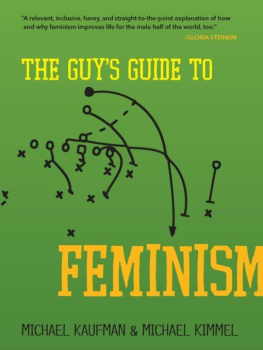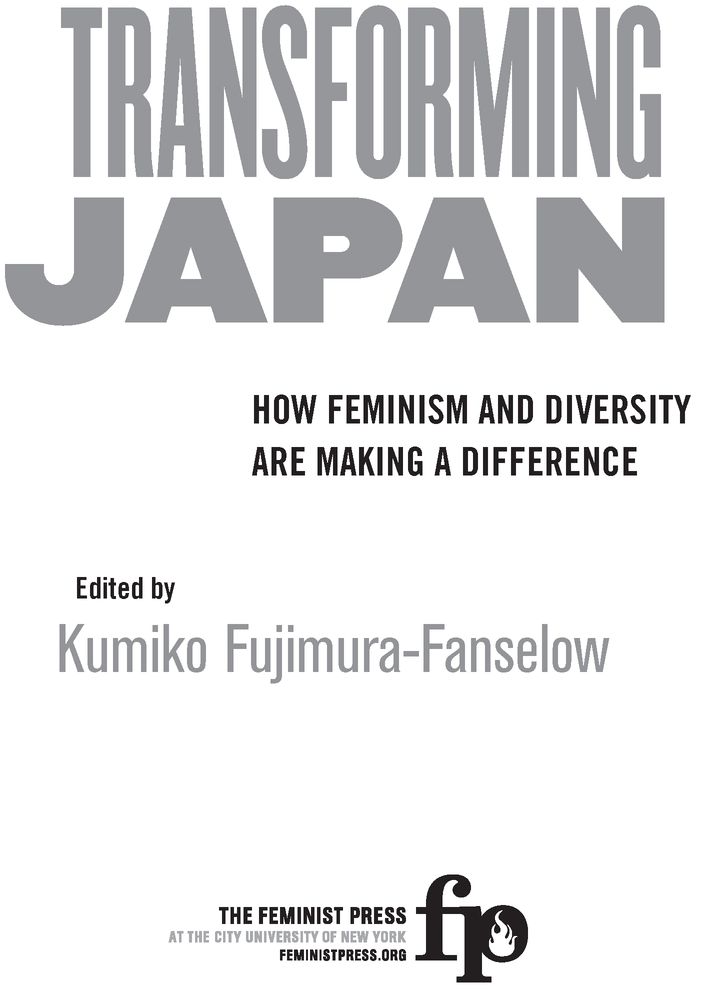Table of Contents
To my daughters
Aya Dorothy and Misa Laura
Japanese practice places the family name or surname preceding the given or first name. However, since the text is in English, many readers will expect the names to appear in Western order. In addition, several authors included as writers, subjects, or references are known in countries outside of Japan where their names have appeared in Western order. Therefore I have followed the Western order of placing the given name first, followed by the family name.
Preface
Almost twenty years ago, I approached Florence Howe, the director of the Feminist Press, with the idea of producing an anthology written by Japanese scholars about Japanese womens lives. The volume took five years to complete. Japanese Women: New Feminist Perspectives on the Past, Present, and Future (1995), which I co-edited with Atsuko Kameda, served a worldwide audience interested in the views of Japanese women scholars. The book created a break in the one-way flow of information between Japan and the rest of the world. While Japanese scholars had considerable access to information about women in other countries through translated works by foreign scholars, this book would bring Japanese womens scholarship to readers abroad. Japanese Women aimed to close the gap between what feminist researchers, scholars, and activists in Japan write and what the world readsmore often than not distorted, exaggerated, or stereotyped in the mass media.
That first volume, intended for students and scholars studying Japan as well as those interested in gaining a cross-cultural perspective on issues concerning women, was adopted as a text in both undergraduate and graduate courses in womens/gender studies courses as well as Japanese/ Asian studies courses in many countries, including Japan and, of course, the US. The essays reflected social, political, and cultural challenges Japanese women have confronted since the end of World War II, as well as the new consciousness that emerged among women beginning in the early 1970s with the birth of the womens liberation movement in Japan and international developments that affected Japanese women.
At the time the book was published, we held some sense of optimism that we could anticipate further progress in womens advancement in the workplace, politics, and education, as described in many of the essays. Such optimism was strongly tempered by other essays that dealt with issues that had yet to be adequately confronted, such as domestic violence and the plight of migrant women, as well as the continuing stagnation of the Japanese economy that would inevitably affect womens status within both the workplace and the home. Five years after the books publication, Florence Howe was already encouraging me to update the book to reflect the changes that had taken place in the intervening years. Florences insistence and encouragement spurred me to take up the task.
Transforming Japan is as comprehensive as Japanese Women, and while it retains five historical essays from the previous volume, the perspective here differs substantially. More than half of the essays focus on aspects of womens lives untouched in Japanese Women. These essays represent the areas of significant change not only in womens lives, but also in Japanese culture. These topics include: the visibility of single mothers; the visibility of lesbian lives in the past and the present; the changing lives of men especially in relationship to parenthood; the new consciousness about Japan as a multicultural society and what that means for minority womens rights.
This book is directed at readers interested in learning about the diverse faces of women living in Japan, who confront challenges and struggles that in many ways overlap, yet in other ways are unique to specific groups. It does not assume sophisticated prior knowledge of Japan or feminist theories. As a feminist, I am committed to making knowledge and books about women accessible to as many readers as possible, so I specifically instructed the authors to avoid the use of academic and feminist jargon.
While most of the contributors to this volume are academics, some are activists associated with nonprofit organizations supporting single mothers and migrant women, one is a lawyer who advocates for womens rights, and several are politicians. All of the contributors share a strong commitment to identifying and addressing human rights issues, especially as they pertain to women, and to working actively to rectify abuses. In addition, many of the authors and translators are themselves members of marginalized/minority groups, and have worked as researchers and advocates. I sought out these authors in the hope that their possession of an intimate knowledge and understanding of the lives, struggles, and accomplishments of particular groups of women, combined with skills of scholarly analysis, would infuse these essays with personal meaning and immediacy.
In the process of editing this book, I asked students enrolled in my undergraduate and graduate classes dealing with gender issues to read several manuscripts, and I invited the authors and translators to speak to my classes. While I was not wholly surprised, I was nonetheless dismayed to discover that the majority of my studentsincluding graduate students who range in age from the midtwenties to fifty-plus, and who work in a variety of professionswere almost totally ignorant or at most had only a vague awareness or superficial knowledge of many important issues, particularly those pertaining to minority groups. The few who knew of the existence of minority groups in Japan believed that whatever discrimination they may have faced in the past no longer existed, that their problems had been resolved.
A striking moment occurred during Malaya Iletos visit. A former staff member at the International Movement Against All Forms of Discrimination and Racism (IMADR), she had translated the essay Buraku Solidarity by Risa Kumamoto on women of the Buraku community (see chapter 16), who continue to face discrimination in Japan. Ileto came to speak to a group of undergraduates about her initial encounter with the Buraku issue. A number of students thought that she had said black and was referring to discrimination faced by black people in the US. While the Japanese pronunciation of black is close to Buraku, the misunderstanding occurred chiefly because these studentslike most Japaneseview racial or ethnic discrimination as something that exists in other countries but certainly not in their own society. Despite the presence of people of various nationalities in Japan, to most students they remain outsiders with whom they have very little contact and whom they perceive as different. Few have talked face-to-face with a person of Buraku origin.
I invited Donna Nishimoto, one of the participants in the research project described in Leny P. Tolentinos and Nanako Inabas essay (see chapter 14, The Story of Kalakasan and Migrant Filipinas), who now works as a Filipina activist, to speak to my students.
With Leny P. Tolentino by her side, who at times took her hand to provide support, Donna described her life in the Philippines, and her coming to Japan in search of employment. She described the violence she endured from her Japanese husband, and the bullying suffered by her Filipino-Japanese son in school. She expressed her determination to recover her dignity and to protect her son by appealing to his teachers for help. Upon hearing her story, the students were visibly moved. Previously, most thought scantily clad Filipina women had come to Japan to make money by soliciting customers in front of bars. Meeting Donna and learning about the reasons and circumstances that bring Filipina women to Japan, and the hardships and challenges they encounter living in Japan, helped to dispel the negative images many students held of Filipina women. At the same time, they viewed Donna and others who suffered abuse and exploitation not simply as victims of ethnic discrimination and violence, but as examples of women who possessed strength and pride in their identity with the determination to improve their own lives and that of other Filipina women and their families.









